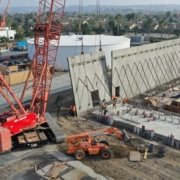Opinion: Will the Drought Contingency Plan Be Enough to Save Lake Mead? Maybe – For Now
Lake Mead is disappearing. It has already fallen more than 146 feet since 2000.
Last week the Bureau of Reclamation forecast that it will likely drop another 42 feet in the next five years, drawing the lake surface down to a level barely sufficient to generate power and release water for downstream water users in California and Arizona.










